EXPLORE THE NAVAJO NATION
BEAUTIFUL MONUMENT VALLEY SITS QUIETLY IN THE NORTHWEST PORTION OF THE NAVAJO NATION
(Note: To enlarge the pictures, just click on the underlined colored text)
Tenacious...adaptable...enduring...spiritual - words that characterize the largest and most influential Indian tribe in North America... The Navajo Nation. Since the Long Walk in the 1860's, the Navajo Nation decimated to a population of only 8,000. It has increased to a stronghold of more than 210,000. About 60 percent of Navajos are 24 years old or younger. In its infancy, the Navajo Nation governed itself by a complex language and clan system. The discovery of oil in the early 1920's clarified the need for a more systematic form of government. So, in 1923, the Navajos established a tribal government; thus providing an entity to deal with American oil companies wishing to lease Navajoland for exploration.
A Navajo elder,Thelma
Nez, in traditional dress is preparing to tend to her daily livestock
chores
Today, the Navajo Nation Council has grown into the largest and
most sophisticated American Indian government in the U.S. , it was reorganized
in 1991 to form a three branch government - executive, legislative and
judicial. It embodies an elected tribal President, Vice-president and 88
council delegates representing 110 local units of government (known as
chapters) throughout the Navajo Nation. Council delegates meet a minimum
of four times a year as a full body in Window Rock, Arizona, the Navajo
Nation capital. In addition to their duties as chapter representatives,
council delegates also are appointed by the tribal council to serve on
at least one of 11 standing tribal committees.
The Navajo Nation continues to forge ahead in its goal to attain economic
self-sufficiency . Yet in the midst of it all, the Dineh (or the People)
still adhere to their cultural, social and traditional values; the same
tenacious values that have made the Navajo Nation unique and fascinating
throughout its history. The traditional history of the Navajo Nation, with
its strong emphasis on adapting trends with modern day America will continue
to perpetuate the enduring Navajo into the future.
Location of the Navajo Nation (Red color: National Parks including Grand Canyon - Blue color: Lake Powell)
The Navajo Nation Tourist Development Initiative
To help revitalize its economy, the Navajo Nation has recently undertaken
steps to develop, strengthen and manage an even increasing tourism industry.
Despite the fact that most tourists visit Arizona to see cowboys and Indians,
it is estimated that only 7 percent of a nearly $550 million industry ever
reaches the Navajo Nation. With the formation of the "Navajo Tourism
Master Plan" it is hoped that the Navajo Nation will be able to reach
more than 20% of tourism expenditures by the year 2000, creating some 5,000
jobs.
Scenic views of Canyon de Chelly can be seen by travelers from highway turn-offs or from the canyon floor
Spectacular rock formations, located throughout the Navajo Nation are enjoyed by all
Explore...The Land
Outsiders do not perceive Navajoland as the Navajo, as the sacred homeland
created for the Dineh. This strong spiritual belief in the land requires
that Mother Earth be treated with the deepest respect. The arid-looking
surface of Navajoland belies what lies underneath a world of hidden treasures...tons
of oil, gas, coal and uranium...waiting to be tapped. In 1987 alone, some
$43 million was poured into the Navajo Nation's coffers from mineral royalty
payments. Coal alone contributed $28 million to the tribal treasury. Minerals
excavated from Navajoland not only benefit the Navajo Nation, but also
provide various forms of energy to millions of people throughout the United
States.
With a burgeoning population, the Navajo Nation has found it necessary
to increase its landbase substantially over the past several years. Some
17.5 million acres have been added to tribal lands. And there are plans
to increase this base even more.
Explore... The Beauty
In addition to its mineral resources, the Navajo Reservation embodies
some of the most awesome and spectacular scenery in the world. More than
15 national monuments, tribal parks, and historic sites are found within
its vastness.
For avid water sports enthusiasts, Navajoland encompasses a dozen different
fishing lakes and ponds, scattered throughout the sprawling 26,000 square-mile
reservation. Lake Powell alone - boast some 186 miles of water front and
2,000 miles of shoreline - more than the entire West Coast!
The stark and incredible beauty of the Navajo Reservation - spilling over
into the states of Arizona, New Mexico and Utah - is an irresistible magnet
to film and television producers from all over the world. Canyon de Chelly
National Park, Monument Valley, Tribal Park, the Little Colorado River
and Rainbow Bridge National Monument, are only a few of the sites that
have been immortalized on the silver screen.
Frequently visited attractions include Chaco Culture National Historical
Park, Navajo National Monument, Window Rock, Four Corners Monument, Petrified
Forest National Park and the Bistri Badlands.
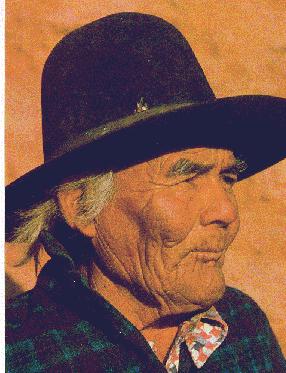
A historic profile of a Navajo elder with a black velvet hat
Explore...Dineh (The People)
Navajo legend tells us that the Dineh had to pass through three different
worlds before emerging into the present world - the Fourth World or Glittering
World. So, the Holy People put four sacred mountains in four different
directions. Mt. Blanca in the east. Mt. Taylor in the south, San Francisco
Peaks in the west, and Mt. Hesperus in the north, thus creating the boundaries
of Navajoland. Centuries ago, the Navajo people were taught by the Holy
People to live in harmony with Mother Earth and how to conduct their many
activities of everyday life. The Dineh believe there are two classes of
beings: the Earth People and the Holy People. The earth People are ordinary
mortals, while the Holy People are spiritual beings that cannot be seen.
Holy People are believed to aid or harm Earth People.
When disorder evolves in a Navajo's life, such as illness, herbs, medicinemen
(diagnosticians), prayers, songs and ceremonies are used to help cure the
ailment. Some tribal members prefer modern day hospitals on the Navajo
Reservation; some seek the assistance of a traditional Navajo medicineman,
some combine both methods. Navajos believe that a medicineman is a uniquely
qualified individual bestowed with supernatural powers to diagnose a person's
problem and to heal or cure illnesses. The Dineh believe they are sustained
as a nation because of their enduring faith in the Great Spirit. And because
of their strong spirituality, the Navajo people believe they will continue
to survive as an Indian nation forever.
Explore...Food and Clothing
For generations, traditional Navajo dishes have been handed down from
grandmother to mother to daughter without being written down. Besides being
a basic necessity of life, food welcomes visitors and expresses thanks.
Traditional Navajos usually cook by memory, measuring their ingredients
with hands or fingers. If there is no modern stove, most food is cooked
over an open fire. Traditional cooks still use wild plants and vegetables
such as spinach, onions, turnips, berries, cactus and cedar brush. For
instance, cedar brush is used to add color, a flavor to a popular Navajo
delight called blue corn meal pudding.
Explore... The Traditional Dress
Many Navajos continue to wear traditional clothing daily. Others wear
their velvet, turquoise and silver only during ceremonial or social gatherings.
The Navajo woman's traditional style of dress consists usually of foot
or knee-high moccasins, a pleated velvet or cotton skirt, a matching long-sleeve
blouse, concho and/or sash belt, jewelry and a shawl. Men also wear jewelry,
moccasins and preferably a velveteen shirt. Although many Navajo people
wear contemporary clothing, they continue to carry on their cultural practices
by wearing traditional outfits when the occasion requires it. It is believed
that before an individual can receive help from the Great Spirit, one must
first wear appropriate clothing in order to be recognized.
Explore...Navajo Language
The Navajo people are very dynamic and creative people who strongly
believe in the power of the mind to think and create; finding expression
in the myriad symbolic creations of the Navajo language, art and ritual
ceremonies.
The Navajo language embodies a high prevalence of humor in day to day conversation.
Humor transforms difficult and frustrating circumstances into bearable
and even pleasant situations. The strong emphasis and value Navajos place
on humor is evidenced in the First Laugh rite. The first time a Navajo
child laughs out loud is a time for honor and celebration.
Aside from being the mother tongue of the Navajo Nation, the Navajo language
also has played a highly significant role in helping the entire nation.
During World War II, the Navajo language was used as a code to confuse
the enemy. Navajo bravery and patriotism is unequaled. Navajos were inducted
and trained in the U.S. Marine Corps to become "code talkers"
on the front-line. Shrouded in secrecy at the time, these men are known
today as the famed Navajo Code Talkers, proved to be the only code that
could not be broken during World War II. Although not all tribal members
speak the language fluently, most Navajos have a deep respect for it.
Explore...The Cultural Events
Navajoland offers several culturally-related activities held throughout
the year. Pow wows, traditional song and dances, native food competitions
and many others are only a sample. 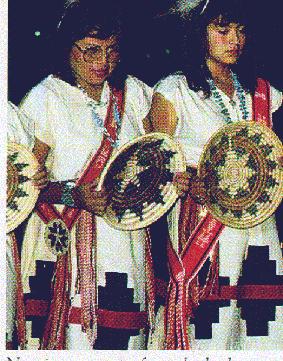
Navajo women perform the basket dance at the Navajo Nation Fair's night performance
The men's fancy dance may be the most exciting part of pow wows that are held
Explore...Navajo Song and Dance
Scarcely anything depicts the American Indian more eloquently than
his love for dancing. The traditional song and dance and inter-tribal pow
wows are only some of the many aspects in which the Navajo Nation continues
its cultural tradition. Most social events held in Navajoland are held
mainly for pleasure and outsiders are welcome to attend.
The traditional song and dance (a ceremony called the Enemyway Ceremony)
is an increasingly popular event. One of the reasons an Enemyway Ceremony
is conducted is to help cure an individual who has become ill after going
to war. The ceremonial dancing is to relieve tension in the patient. Today,
the cultural aspects of the ceremony live on through song and dance contests
or festivals. Participants dress in their finest traditional Navajo attire
and recreate the traditional dances of their forefathers.
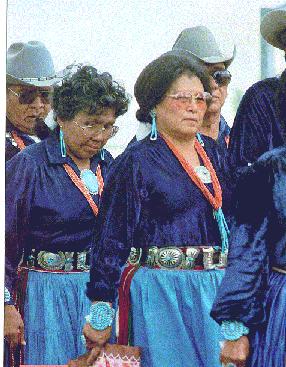
Social traditional dancing is a favorite pastime for many Navajo People, but it also can be a form of competition as shown here
Explore...Pows Wows
Although pow wows did not originate with the Navajo people, the Navajo
Nation hosts one of the largest intertribal pow wows in North America every
summer in Window Rock, Arizona during the Navajo Nation Fair. Most modern-day
pow wows are held for pleasure , but certain aspects of the pow wow are
sacred and in some cases photographs and tape recorders are forbidden.
Explore...The Navajo Nation Fair
The Navajo Nation proudly sponsors the "World's Largest American
Indian Fair" - the Navajo Nation Fair - attracting visitors from around
the world. Held in early September each year, the fair takes place in Window
Rock, Arizona, capital of the Navajo Nation, where more than 100,000 people
attend the five-day gala.
One of the highlights of the fair is the all-Indian rodeo, lassoing in
more than 900 Indian cowboys and cowgirls from eight different Indian rodeo
associations throughout North America. The Navajo Nation Fair Rodeo offers
competition in all events for both men and women.
The Navajo Nation Fair offers a variety of other events including horseracing,
an inter-tribal pow wow, arts and crafts exhibits of world-renowned Indian
artists, Miss Navajo Nation competition, an Indian fry bread contest, a
baby contest, concerts, country and western dances, song and dance competition,
agricultural exhibits, livestock exhibits, food concessionaires, a carnival,
and of course, the Navajo Nation parade through the Window Rock area.
Following the Navajo Nation Fair are other Navajo fairs - the annual Shiprock
Navajo Fair, held every October in Shiprock, New Mexico. This is the most
traditional of all Navajo fairs. Other smaller tribal fairs include the
Western Navajo Fair in Tuba City, Arizona, the Eastern Navajo Fair in Crownpoint,
New Mexico, and the Central Navajo Fair in Chinle, Arizona; all usually
held in early fall.
Explore...The Outdoors
Hearts pound, sides ache, muscles ripple...as men and women of all
ages push their bodies to the limit in a 10K run...water sparkles the glints,
a sudden breeze rises as you cast a line out to the crafty fish lurking
beneath the surface of one of several fishing lakes; a wild cheer, a collective
"Oooh"...as the summer crowds cheer their favorite softball team;
the buzz of a power boat as it zooms along pulling water skiers in tow.
This is Navajoland! Navajoland with its myriad variety of outdoor recreation.
Fishing, hunting, running, hiking, cycling, boating, softball, basketball,
and numerous other exhilarating activities, challenge the most avid sportsperson.
Navajoland offers everything, from some of the most grueling cycling races
to highly competitive trophy fishing, ranking among the top outdoor recreation
anywhere.
Explore...Fishing and Hunting
Navajoland offers fishing year-round at its 12 major lakes. Most popular
are Wheatfields and Tsaile in Arizona, and Whiskey Lake in New Mexico.
Most of the tribe's lakes are nestled in the Chuska Mountains located in
the east-central area of the Navajo Reservation. Avid fishermen match wits
with an array of fish ranging from rainbow and cutthroat trout to channel
catfish.
If hunting is your bag, Navajoland offers both small and big game hunting.
A variety of big game (primarily deer and turkey) hunts are offered beginning
in mid September and expanding into December. Most small game is in season
year-round. The permits required for fishing, hunting and boating can be
obtained from the Navajo Fish and Wildlife Department.
Explore...Fitness
Maybe your idea of exercise is to walk and explore? Or maybe bicycle?
A road race? The Navajo Nation hosts several such races throughout the
year, however, we also offer less competitive exercising with outstanding
background beauty.
Throughout the spring and summer, Navajoland is inundated with distance
runners and cyclists warming the muscles and taking part in one or more
of a host of races.
Navajos have long been famous for their long distance running ability.
With this challenge and beauty-filled background, Navajoland becomes a
"special" magnet for racers from all over the Southwest. Cyclists
from all over the Southwest venture onto the reservation battling the uphill
challenge of the Chuska Mountains and the unrelenting sun of the great
Navajo Nation.
So, when you think you're ready...pick up the tanning lotion , loosen up
those muscles, and come on out to the Navajo Nation to compete with the
best of them in a 5K, 10K, or 25-mile cycling race. If leisure jogging
or bicycle riding is more your pace, Navajoland offers spectacular scenic
background and crisp, fresh air guaranteed to quicken your pulse and catapult
you into a real love affair with Navajoland.
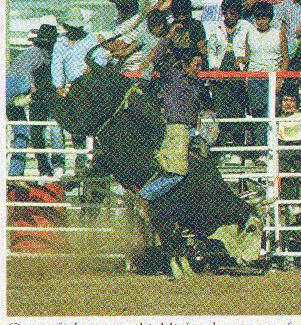
One of the most highlighted events of the rodeo is the bull riding competition
Explore...All Indian Rodeos
Grab your cowboy hat, shine-up your boots, and head out to the Navajo
Nation's number one spot - rodeo. Want to see cowboys and Indians? Well,
on the Navajo Nation, most cowboys ARE Indians! There are literally hundreds
of rodeos in Navajoland. In fact, the Navajo Nation hosts more Indian rodeos
than any other tribe in the United States and Canada combined. Even during
the winter months, Navajos continue jackpot team roping and bull riding
competition.
Virtually every region of the Navajo Nation hosts a rodeo during the summer,
offering participation in all events for both men and women. The Navajo
Nation Rodeo Cowboys Association and the All-Indian Rodeo Cowboys Association
hosts several rodeos on the Navajo Reservation throughout the season. Yaahoooooooooo!
Love those Indian rodeos!

Navajo craftspeople use a variety of materials for their final product, such as this raw coral displayed with a coral necklace
Explore...Indian Artwork
Navajo rugs, their unique silversmithing, and distinctive baskets are
recognized throughout the world. Everyone loves Indian art - particularly
Navajo art. Yet most guests visiting the Navajo Nation are not aware of
the history or significance of most artwork to the Navajo people. Nor do
most guests understand what constitutes "authentic" Navajo crafts.
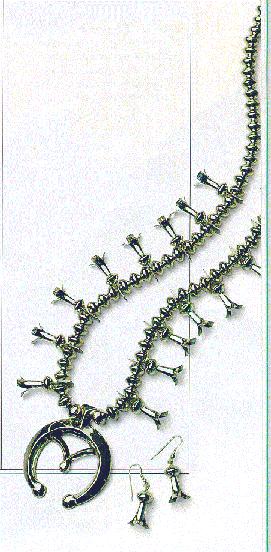
The squash blossom necklace is considered to be one of the most traditional jewelry pieces of the Navajo, as displayed here in silver (on the left)
Concho belts are commonly worn by both men and women throughout Navajoland as daily or ceremonial wear. This "Storyteller" belt is a unique design of Navajo craftmanship (on the right).
Rug weaving for the Navajo can lead to a successful way of life, but most guests visiting the reservation enjoy choosing the right rug for their purchase
Explore...Rug Weaving
Fascination for Navajo weaving is unequaled from its arts and crafts
enthusiasts throughout the world, not only because of its aesthetic qualities,
but also because of its unique stylistic changes.
Navajo legend teaches that Navajo women learned the art of weaving from
Spider Woman who constructed a loom according to directions given by Spider
Man. They were Holy People who came from the underworld, where weaving
was their way of life. However, others believe that Navajo women learned
the technique from Pueblos in the mid-17th Century.
Originally Navajo women wove such items as wraparound dresses, tunic-like
skirts, breech cloths, and shoulder robes. just prior to 1900, the market
for Navajo blankets expanded into rugs and weaving eventually became market-oriented.
Today, distinct styles of rugs identify designs from Two Grey Hills, Ganado,
and Crystal, which have become famous worldwide. Although many weavers
continue in their regional style, some artists who live in the vicinity
of two rug regions have become combination-style weavers.
Branching out from the traditional rugs are the difficult and complex designs
such as the two-faced, pictorial, sandpainting and raised outlook. The
saddle blanket, another popular rug, isn't as difficult to make as the
others, but is more affordable for the collector on a limited budget.
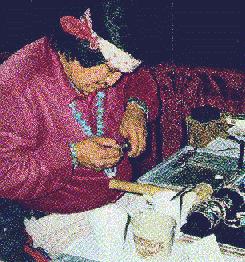
Silversmithing requires a tremendous amount of patience and a keen eye for quality
Navajo artisans are famous for their quality work on a variety of arts and crafts
Explore...Silversmithing
Navajos are unsurpassed in their ability to create exquisite and multifaceted
art. Nowhere is this more true than in the beauty of their silversmithing.
Introduced by the Spaniards and Mexicans around the middle of the 19th
Century, silversmithing Navajos obtained metal by melting down American
silver dollars or Mexican pesos.
Navajo lore teaches that when the Dineh came from the underworld, First
Man brought turquoise with him and directed shovels to be made of turquoise
to dig channels and drain much of the water that was present. It's believed
that Navajos began working with turquoise after returning from Fort Sumner,
New Mexico in 1863. Aside from its ornamental value, turquoise is especially
important to the Navajo people because of its ceremonial significance.
Today, turquoise is used primarily for ornamentation, but Navajos remember
and wear it ceremonially as exemplified in the many rituals still held
today.
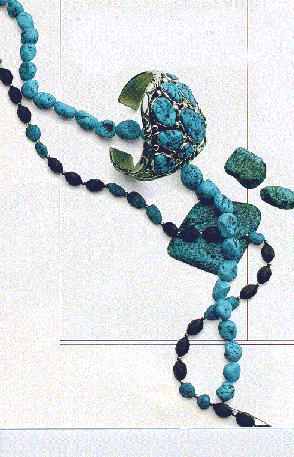
Not only do Navajo craftspeople work with silver and turquoise , as displayed here in this beautiful bracelet, but black onyx, gold and other such materials are often used
Explore...Basketry
While the art of basketmaking may seem minor, a basket has great symbolic
significance because it represents the well-being of an individual, particularly
the mind.
Navajo lore teaches that Holy People - First Man and First Woman - made
baskets when they lived in the underworld for ceremonial purposes. Each
part of a Navajo basket has a special significance. The core of the basket
represents the emergence of the Holy People into the present world - the
Fourth or Glittering World. The area surrounding the core represents the
earth. Traditional Navajo baskets have a first layer of black triangular
design, representing the four sacred mountains. That area immediately adjacent
to the black represents the sky; the red design represents the clouds and
darkness. The black triangular designs on the outside of the basket represents
the Holy People., including Yellow Corn and Dawn. Finally, the outer edge
of the basket represents the association with others.
Apart from their ceremonial usage, Navajos also use baskets for ornamentation.
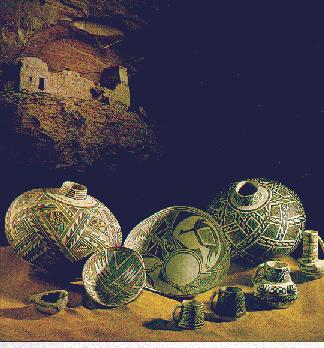
Black-on-white prehistoric pottery from the southwest. Background is Mummy Cave, Canyon de Chelly National Monument near Chinle.
Sandpaintings also are popular native crafts to visitors.The Bolo Tie is the Southwestern version of the Eastern Silk, Paisley Tie
Explore...Sandpainting
Sandpaintings are another unique and symbolic art form originating
with the Holy People who lived in the underworld. Sandpaintings were, and
still are, primarily ceremonial.
Depicting the tools used by the Holy People, which were strictly intended
for ceremonial purposes, sandpaintings represent an array of ceremonies
and sacred songs. However, today many artists create pictures of ceremonial
figures for commercial purposes. Sandpainting in itself is not forbidden
as long as Holy people are not depicted. A spin-off of ceremonial sandpaintings,
are the popular sandpainting nameplates, containers, vases, etc., decorated
with figures other than ceremonial. This allows the art form to be collected
and enjoyed without compromising sacred ceremonial values.
Tribal legend indicates that most Navajo arts and crafts sprang from roots
that began with the Holy People. Virtually everything a Navajo says or
does is somehow linked with his cultural past, consequently they help him
set the course for the future. Navajoland is, as it has always been, a
land in transition, a blending of the past and the present, reaching out
confidently to embrace the future.
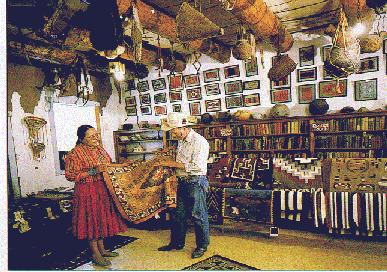
Upon completion of most crafts, Navajos visit local trading posts to sell the crafts to the trader for resale (Hubell Trading Post)
Silver and turquoise Squash Blossom Necklaces are always a favorite among guests visiting the Navajo reservation (right)
Courtesy The Navajo Nation - Copyrights and All Rights Reserved 1996
Photography credit: JERRY JACKA
For more information, please contact: NAVAJOLAND TOURISM P.O. Box 663 Window Rock, Arizona 86515
Phone: (520) 871-7371
(520) 871-6436
Fax: (520) 871-7381

Monument Valley Tribal Park
Monument Valley
Navajo name: Tse' Bii' Ndzisgaii
Probably the most famous of the Navajoland National Parks. It was the original
northwest corner of the Treaty Reservation in 1868. In 1884 an Executive
Order annexed the areas north and west of Monument Valley into the present
Navajo Reservation. It was established as the first Navajo Tribal Park
on July 11, 1958 by the Navajo Tribal Council.
Annually over 400,000 tourists from all over the world visit Monument Valley
Tribal Park.
Monument Valley has been used for many western movies including:
1939 - "Stagecoach"
1946 - "My
Darling Clementine" A story about the film can be found:HERE
1956 - "The
Searches" A story about the film can be found:HERE
1962 - "How
The West Was Won"
1974 - "The
Trial of Billy Jack"
1981 - "The
Legend of the Lone Ranger"
1990 - "Back
To The Future III"
For more information contact: Monument Valley Navajo Tribal Park,
P.O. Box 360289, Monument Valley, Utah 84536 Tel. (801) 727-3353 or 3287
White House ruins - Canyon de Chelly

Canyon de Chelly
National Monument
Nowhere throughout Navajoland is it more profound to find a blend
of the past and present cultural tradition than at Canyon de Chelly National
Monument, one of America's 8 best National Monuments according to National
Geographic's Traveler Magazine. It was established as a National Monument
in 1931.
See how the Navajo people still have a mystical bond to Mother Nature as
you partake of the legendary beauty of this magnificent historical site.
Located three miles east of Chinle, Arizona on U.S. Highway 191, Canyon
de Chelly National Monument houses about five periods of Indian culture
dating from 350 AD to 1300 AD. The 26-mile canyon of red stones rise from
30 to 1,000 feet which provide a spectacular backdrop for hundreds of Anasazi
ruins, Navajo homes and farms.
Thousands of years ago humans moved into this high desert country. The
Anasazi's (or
as the Navajo people call them; the "Ancient Ones") at first
erected simple brush windbreaks and pit houses sunk in the ground; later
they built stone villages right into the canyon walls. Then after several
droughts about 700 years ago, the Anasazi moved away. Now empty, their
time-worn ruins pique the imagination.
The stone houses crowd a ledge beneath a 452-foot-high sandstone alcove.
Their walls are intact, with many of the stick-and-mud roofs still in place.
For more information contact: Superintendent, Canyon de Chelly National
Monument, P.O. Box 588, Chinle, Arizona 86503. Tel. (Visitor Center) (520)
674-5500
Navajo Nation Links:
1. Great Seal of the
Navajo Nation
2. Navajo Tourism Department
- Welcome to Navajoland
3. The Navajo Nation
Map
4. Navajo
Nation - Lukachukai, Arizona
5. Navajo Nation
Directory
RETURN TO NATIVE
AMERICANS HOME PAGE
